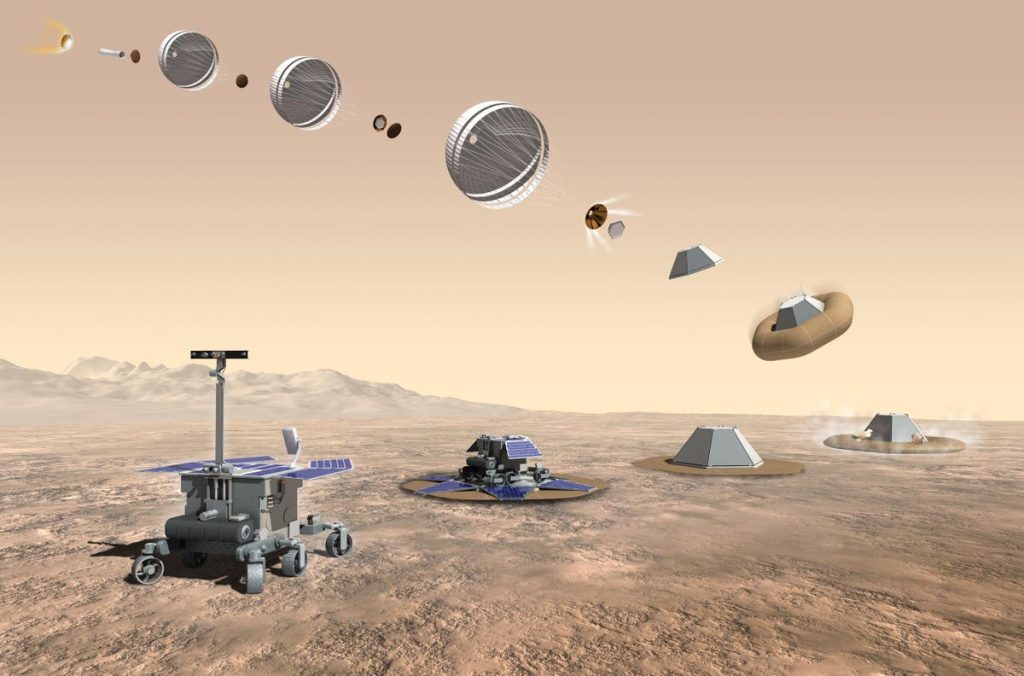After centuries of wondering whether Mars has (or ever had) life, by early next decade humanity may finally get real answers. With the projected 2028 launch of its ExoMars Rosalind Franklin rover, the European Space Agency (ESA) could potentially make an in-situ detection of past or even present life up to six feet beneath the Martian surface. If so, it might beat NASA to the astrobiological punch by at least two years.
NASA is counting on a sample return mission to ferry samples being collected by its Perseverance rover to finally clear the air on the possibility of life on the Martian surface. But at earliest, its return samples aren’t expected to arrive here on Earth until 2033.
ADVERTISEMENT
Until ESA’s much-delayed Rosalind Franklin rover launches, however, all bets are off. But the ESA rover does have much going for it. The heart and soul of the ExoMars rover is MOMA (the Mars Organic Molecule Analyzer), built as a collaboration between Germany, the U.S. and France.
The plan is for ESA’s rover to land in October 2030. Unlike NASA’s Perseverance and Curiosity rovers, the Rosalind Franklin rover will primarily rely on solar power to keep its instruments functioning during its nominal mission of about seven months. On a good day, the rover should be able to travel some 70 to 100 meters while sampling subsurface sediments. And it will begin data collection as soon as possible after landing.
Did Mars once have an ocean?
Among other things, the ESA rover could answer whether Mars once had a northern ocean, the only such ocean thought to have existed on Mars. In fact, the ESA rover’s landing site in the Oxia Planum region may be in the southernmost point of this potential ancient ocean.
ADVERTISEMENT
It has a delta at the very tip of our landing ellipse that is dated at 3.9 billion years, Jorge Vago, the ExoMars Project Scientist, recently told me in his office at ESA ESTEC in The Netherlands. As far as we can tell, the entire area all the way to Mars’ North Pole must have been inundated by several tens of meters of water, he says.
Some four billion years ago, it’s likely there were microbial colonies living in some sort of hydrothermal system beneath the surface of Oxia Planum. Because Mars is thought to have been very volcanically active at the time, ash from its volcanoes would have fallen on its ocean’s surface. Once Mars lost its water and dried out, these microbial colonies would have turned into microfossils preserved by this sedimentary ash. The ensuing cold temperatures beneath the surface would also have aided in their preservation.
ADVERTISEMENT
Once Mars lost its surface water, it turned very cold, says Vago. Dig a foot and a half below the surface and the temperature is minus 60 degrees Fahrenheit; it’s a wonderful freezer, he says.
MOMA must first vaporize the compounds it collects so they can be detected by the instrument’s mass spectrometer. Mass spectrometers measure the chemical makeup and mass of given substances in gaseous states. To do so, MOMA will either use heat or ultraviolet laser pulses to convert chemical species in the samples into a gas phase. Then these gas phase chemical samples will undergo onboard analysis to determine if they look promising for biology in both their makeup and their distribution.
Instead of thermal heat, MOMA will use a laser to separate the largest organic compounds from the minerals to which they were originally bound. This will enable the team to avoid sample contamination by perchlorates, colorless and odorless salts, that can be an unwanted byproduct of the kind of heat needed to conduct such sample analysis.
The probability that we will find organic molecules, I think is like 100%, says Vago. The probability that we may find something that is suggestive of life is something like 50%, he says.
ADVERTISEMENT
What is MOMA’s biggest scientific challenge?
Converting results into significance, Fred Goesmann, MOMA’s Principal Investigator, and a planetary scientist at Germany’s Max Planck Institute in Gottingen, told me via email. While the identification of molecules will most likely contain little ambiguity, the significance for “life detection” is tricky, he says. The optimists will declare to have seen evidence for life while the pessimists will carefully search for non-biological explanations, says Goesmann. We need both sides for a consistent interpretation, he says.
Will MOMA provide proof of life?
‘Proof’ is a big word, says Goesmann. When it comes semantics at a hypothetical post-detection press conference, he says that rather than ‘this was/is life,’ official statements are more likely to read: ‘Currently, the only explanation for our results is life; we could not think of any other way to produce our findings.’
Will MOMA be able to differentiate between past and present life?
Present life would give itself away via the sheer quantity and good state of preservation of the biomolecules, says Vago. When organisms are metabolically active, they can repair any radiation induced damage so we would have access to a high concentration of biomolecules, he says.
ADVERTISEMENT
As for past life?
The microbes would have died long ago; the cell membranes would have ruptured and their chemical guts spread into the geological record, says Vago. Depending on how they were entombed, they may be preserved, he says.
If we happen upon past life relics, we need to be able to tick a good number of independent biosignatures and to do it repeatedly with various samples, says Vago.
The bottom line?
The key is to build a body of evidence that cannot be explained away by anything other than biology, says Vago.
Read the full article here










